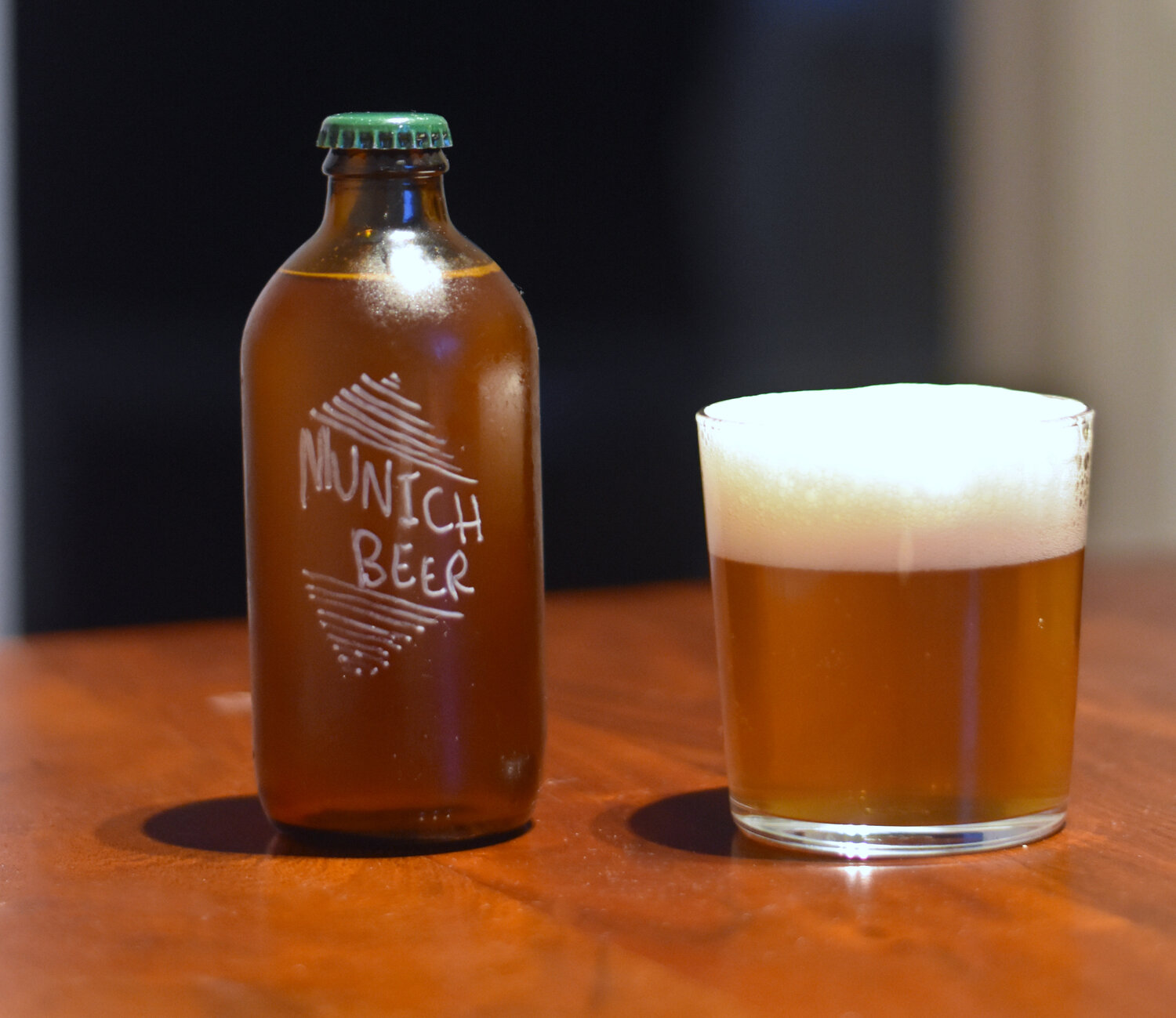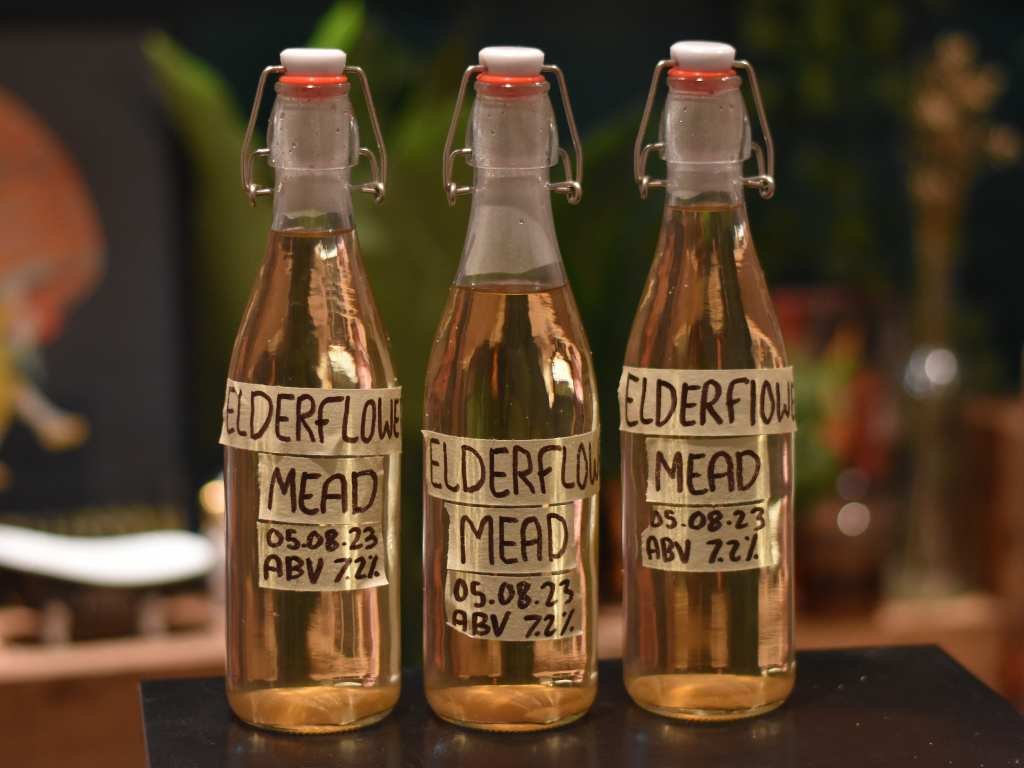How Do You Make Mead | Simple Mead Recipe
How to Make Mead: A British Bartender's Guide to Crafting Honey Gold at Home
Hey there, Homebrewing Hero! Ready to embark on a mead-making adventure? I'm your friendly British bartender-turned-homebrewing enthusiast, here to help you whip up some liquid gold in your own kitchen. So, grab a seat, and let's dive into the sweet world of mead-making.
What is Mead?
Mead, my friend, is the OG of alcoholic beverages. It's been around since the dawn of time and is crafted from one of the sweetest gifts of nature – honey. Think of it as the ultimate honey wine, with variations ranging from sweet nectar to dry elixir and everything in between.
Basically, it’s wine but instead of fermenting grapes, you ferment honey. Which for countries that didn’t have large grape growing climates such as Britain or Scandinavia was the best option for wine making.
What is Honey Wine?
Honey wine? Oh, that's just another way to say mead. It's like calling your mate by their first and last name; it's the same brilliant character but with a touch of sophistication. And let's be honest, nothing screams sophistication like crafting your own honey-infused beverage.
What is Viking Blod Mead?
Viking Blod Mead isn't just any run-of-the-mill mead; it's a tribute to the warriors of old, crafted with spices and vigor to match their fiery spirit. Its name, "Viking Blod," translates to "Viking Blood" in English and is named after the look, for this is a deep red mead.
The reason for the coloring is thanks to the addition of hibiscus. Other produce may also add cherry wine to achieve the same look.
History of Mead
Mead, the nectar of the ancients, traces its roots through the annals of history, leaving a trail of honeyed tales across various civilizations. The Greeks revered it as the "nectar of the gods," associating mead with ambrosia – the food of the divine.
In the halls of Valhalla, Viking warriors raised their drinking horns filled with mead, believing it to grant them strength and courage worthy of the battlefield. The legendary sagas are sprinkled with references to the intoxicating elixir, cementing mead's status as the drink of champions.
Jumping forward to medieval times, mead held court as a symbol of love and fertility. Newlyweds would partake in a month-long "honeymoon," consuming mead to ensure a fruitful union – hence the origin of the term "honeymoon."
Now, onto a bit of mead trivia! Did you know that the term "bridal" stems from the Old English word "brýd-ealo," meaning "bride ale," a honey-based brew that was consumed during weddings? Mead has woven itself into the fabric of human celebration for centuries.
Why Mead Holds Importance in Britain:
Now, let's unfold the pages of history to discover why mead holds a special place in the hearts and goblets of Britain. While the roots of mead extend globally, Britain has its own unique love affair with this ancient elixir.
1. Historical Connections:
Cheers, Celts and Anglo-Saxons: In ancient Britain, mead wasn't just a beverage; it was a cultural cornerstone. Celts and Anglo-Saxons, the early inhabitants of these lands, considered mead not only a drink of celebration but also a symbol of hospitality and kinship. Feasting halls echoed with laughter, song, and the clinking of mead-filled horns.
2. Romantic Tradition:
Medieval Romance: Fast forward to medieval Britain, and you'll find mead at the heart of romantic traditions. Newlyweds would indulge in "mead month" after their wedding, savoring the sweet nectar to ensure a fruitful and joyous union. Mead became intertwined with love and commitment, creating a tradition that resonates to this day.
3. Monastic Mead Makers:
Monks and Monasteries: Monastic life in medieval Britain wasn't all solemn prayers; it included the art of mead-making. Monks cultivated beehives, producing honey for mead within the hallowed walls of monasteries. Mead was not just a beverage; it was a product of patience, craftsmanship, and a touch of divine inspiration.
4. Modern Renaissance:
Craft Mead Resurgence: In recent years, Britain has witnessed a resurgence in craft mead-making. Artisanal meaderies have popped up, offering a diverse range of meads that pay homage to tradition while embracing innovation. This revival has sparked a renewed interest in mead as a beverage that transcends time.
In essence, mead isn't just a drink in Britain; it's a vessel carrying the stories of the past, the warmth of community, and the timeless connection between people and the land. So, as you embark on your mead-making journey, remember that you're not just crafting a beverage – you're contributing to a tradition that has woven itself into the very fabric of British culture. Cheers to the honeyed heritage of Britain!
Mead Ingredients
Now, let's get down to business – the ingredients. It's a simple trio: honey, water, and yeast. But here's the secret – the quality of your honey matters. So, don't skimp on the good stuff; your taste buds will thank you later.
Mead Making Home Equipment:
Now, let's gear up for your mead-making escapade. Each piece of equipment plays a crucial role in bringing your liquid gold to life.
Fermentation Vessel
This is your mead cauldron. It's where the magic begins, where honey meets water, and yeast joins the party to initiate fermentation. Choose a vessel with an airlock to keep unwanted guests (we're looking at you, bacteria) out.
I recommend glass for mead making. I also recommend a 1 gallon (5 litre) batch. Most recipes including this one will be suitable for that amount, it’s a nice amount and you can always pick up more vessels if you would like to do a bigger batch.
So a 5 litre or 1 gallon demijohn will be your best friend here.
The Kind I Use
Airlock
Picture the airlock as the gatekeeper of flavor. It allows carbon dioxide to escape during fermentation without letting any nasties in. A crucial tool for a clean and successful brew.
Siphon
The siphon is your liquid conductor. It helps you transfer your mead from one vessel to another without disturbing the sediment, ensuring clarity and a smoother taste.
The Siphon I Use
Bottles
Once your mead has aged to perfection, it needs a home. Bottles, whether capped or corked, are where your creation rests until it's time to uncork and savor. I prefer swing top bottles because A) they are the safest when it comes to avoiding fermentation related explosions, and B) they are the best value for money since you can keep re-using them again and again.
The Bottles I Use
Sanitization Supplies
Cleanliness is next to godliness in brewing, and this is the nectar of the gods afterall. Sanitizing solutions and brushes ensure that your equipment is free from any unwanted hitchhikers that could spoil your mead.
Basic Cleaner
Now, armed with your fermentation vessel, airlock, siphon, bottles, and sanitization supplies, you're ready to step into the shoes of a mead-making maestro. These tools, though seemingly humble, are the key to unlocking the alchemical process that transforms honey and water into the liquid ambrosia we call mead.
Mead Variations
The beauty of mead lies in its versatility. Feeling creative? Let's talk variations.
Blackberry Mead
For a burst of fruity goodness, try your hand at Blackberry Mead. Picture this – the rich sweetness of honey entwined with the tart dance of blackberries. It's a match made in mead heaven. Here's a simple recipe to get you started:
Ingredients:
3 lbs honey
1 lb blackberries
Water
Wine yeast
Steps:
Combine honey, blackberries, and water in your fermentation vessel.
Add your chosen wine yeast.
Let it ferment, baby!
After a few weeks, rack it into another vessel, leaving the sediment behind.
Bottle that liquid magic and let it age gracefully.
Elderflower Mead
For a more delicate touch, Elderflower Mead is your go-to. The subtle floral notes of elderflowers will transport you to a meadow in full bloom. Ready to give it a shot?
Check out my full elderflower mead recipe here with tips on foraging for wild elderflowers.
Tips and Tricks
Now, let me share some bartender wisdom to elevate your mead game.
Honey Harmony: Choose your honey wisely; different varieties bring unique flavors. Experiment and find your sweet spot. Did you know Honey is among the most adulterated foodstuffs globally, the best way to avoid this and to achieve a real good mead is to shop local for honey. I’m lucky in that I live right next to an apiary (though you wouldn’t call me lucky in the summer when bees are all over my garden) but it means I can shop for good local honey that isn’t just dyed sugar syrup.
Yeast Matters: The yeast you choose can influence the final flavor. Go wild with different strains to find the one that tickles your taste buds. My favorite for mead is champagne yeast.
Bottling Mead
Ah, the moment of truth – bottling. Exercise patience; good things come to those who wait. Follow these steps:
Sanitize Everything: Before you start, make sure your bottles and equipment are squeaky clean.
Siphoning Time: Use a siphon to transfer the mead from the fermentation vessel to the bottles, leaving sediment behind.
Cap It Right: Seal the bottles with caps or corks, depending on your style.
Age with Grace: Let your mead age like a fine wine. Patience is key, my friend.
How is Mead Made Step by Step
Let's break down the mead-making process into simple steps:
Combine honey, water, and any additional flavors in your fermentation vessel.
Sprinkle in the yeast and let the fermentation party begin.
Allow the magic to happen over the next few weeks.
Transfer your mead to a new vessel, leaving the sediment behind.
Once it's clear and crisp, bottle it up, and let it age to perfection.
Below are 3 videos of my own mead and elderflower champagne making which you can use if you’re a visual learner. The recipe for basic mead is the same just don’t use any elderflower.
Mead FAQ’s:
Let's tackle some burning questions you might have:
Is it hard to make mead at home? Not at all! With the right ingredients, a bit of patience, and a dash of creativity, you'll be a mead-making maestro in no time.
How long does it take to ferment mead? Ah, the waiting game. Typically, fermentation takes a few weeks, but the aging process is where the magic truly happens. Aim for a few months to let those flavors mingle and dance.
Is mead stronger than wine? It can be, depending on how you brew it. The alcohol content varies, but mead has been known to hold its own against some robust wines.
And there you have it – a crash course in crafting your own mead. It's a journey of flavors, patience, and a touch of wizardry. So, roll up your sleeves, gather your ingredients, and let the mead-making magic begin. Cheers to your upcoming adventures in the world of honey gold!
Similar Recipes
How to check the ABV of your homebrew
You’ll need to use a hydrometer to check the Alcohol By Volume (ABV) of homemade mead, follow these steps:
Initial Gravity Reading (OG):
Take a sample of your mead before fermentation begins. This is your initial gravity reading. Here is the hydrometer you want if you’re US based, and here’s one if you’re UK based.
Fill a sanitized container with enough mead to submerge the hydrometer.
Place the hydrometer in the sample, and spin it gently to release any air bubbles that may cling to it.
Take the reading at the point where the surface of the liquid intersects with the hydrometer scale. This reading is your original gravity (OG).
Fermentation:
Allow your mead to ferment. As the yeast converts sugars into alcohol, the gravity will decrease.
Final Gravity Reading (FG):
When fermentation is complete, take another sample of your mead using a sanitized container.
Place the hydrometer in the sample, spin gently to remove bubbles, and take the reading at the point where the liquid intersects with the hydrometer scale. This reading is your final gravity (FG).
Calculate ABV:
Subtract the FG from the OG. The difference represents the amount of sugar that has been converted to alcohol.
Use an online calculator or formula to convert this difference into ABV. The formula is often something like: ABV=(OG−FG)×131.25 This formula assumes that the OG and FG are in specific gravity units. For example, if the original is 1090 and the end is 0990 then you would do 1090 - 0990 = 100. Then 100 x 131.25 = 13,125. Meaning the approx abv is 13.1%. But honestly, just take the numbers and bunch them into a few different online abv calculators and you’ll get an answer.
Adjustments:
Some hydrometers are designed for use with different liquids, so make sure you're using a hydrometer calibrated for use with alcoholic beverages. Adjustments may be necessary if your hydrometer is calibrated for a different liquid.
Temperature Correction:
Hydrometers are typically calibrated for a specific temperature, often 60°F (15.5°C). If your mead is at a different temperature, you may need to apply a temperature correction using a correction table or calculator.
Always remember to follow proper sanitation procedures when taking samples to avoid contamination. Additionally, be cautious when opening fermentation vessels to avoid introducing contaminants or disrupting the fermentation process.How to check the ABV of your homebrew
You’ll need to use a hydrometer to check the Alcohol By Volume (ABV) of homemade mead, follow these steps:
Initial Gravity Reading (OG):
Take a sample of your mead before fermentation begins. This is your initial gravity reading. Here is the hydrometer you want if you’re US based, and here’s one if you’re UK based.
Fill a sanitized container with enough mead to submerge the hydrometer.
Place the hydrometer in the sample, and spin it gently to release any air bubbles that may cling to it.
Take the reading at the point where the surface of the liquid intersects with the hydrometer scale. This reading is your original gravity (OG).
Fermentation:
Allow your mead to ferment. As the yeast converts sugars into alcohol, the gravity will decrease.
Final Gravity Reading (FG):
When fermentation is complete, take another sample of your mead using a sanitized container.
Place the hydrometer in the sample, spin gently to remove bubbles, and take the reading at the point where the liquid intersects with the hydrometer scale. This reading is your final gravity (FG).
Calculate ABV:
Subtract the FG from the OG. The difference represents the amount of sugar that has been converted to alcohol.
Use an online calculator or formula to convert this difference into ABV. The formula is often something like: ABV=(OG−FG)×131.25 This formula assumes that the OG and FG are in specific gravity units. For example, if the original is 1090 and the end is 0990 then you would do 1090 - 0990 = 100. Then 100 x 131.25 = 13,125. Meaning the approx abv is 13.1%. But honestly, just take the numbers and bunch them into a few different online abv calculators and you’ll get an answer.
Adjustments:
Some hydrometers are designed for use with different liquids, so make sure you're using a hydrometer calibrated for use with alcoholic beverages. Adjustments may be necessary if your hydrometer is calibrated for a different liquid.
Temperature Correction:
Hydrometers are typically calibrated for a specific temperature, often 60°F (15.5°C). If your mead is at a different temperature, you may need to apply a temperature correction using a correction table or calculator.
Always remember to follow proper sanitation procedures when taking samples to avoid contamination. Additionally, be cautious when opening fermentation vessels to avoid introducing contaminants or disrupting the fermentation process.
Mead Recipe

Mead
Ingredients
Instructions
- Mix everything together in a clean demijohn. It helps the honey dissolve if the water is warm at this point.
- Add the yeast and swirl. On your packet of yeast, it will give instructions on what temperature you should ferment in. I'm from a cold region, so I keep my demijohn wrapped in a blanket in the back of a dark cupboard.
- Fermentation will take approximately 7 days depending on how much honey and how cool/warm the temperature is. After this, you can bottle and refrigerate your mead. If you have an airlock on your demijohn, you'll know when the fermentation is done because the airlock will stop bubbling.
Notes
Once you've done this once, play around with the types of honey and amounts of honey to create your own signature mead. Use a hydrometer if you want to test the abv. Instructions can be found above on how to use them.
Nutrition Facts
Calories
275.81Fat
0 gSat. Fat
0 gCarbs
74.75 gFiber
0.18 gNet carbs
74.57 gSugar
74.48 gProtein
0.27 gSodium
22.56 mgCholesterol
0 mgThe nutritional information shown is an estimate provided by an online nutrition calculator. It should not be considered a substitute for a professional nutritionist’s advice. See our full nutrition disclosure here.
Search Drinks
Cocktails, Non-alcoholic, Wine, Coffee, Drink guides, Techniques, Fermentation
All Recipes
Hi, I’m Cameron, guv’nor of Smartblend. If you liked this then you’re in luck, I have a bunch more recipes like it. I share only vegetarian and pescatarian food recipes, cocktails, and drink guides with a sprinkling of wellness and mindful drinking. If that sounds like you, then stick around!
Related Recipes
Smartblend is a participant in the Amazon Services LLC Associates Program, an affiliate advertising program designed to provide a means for sites to earn advertising fees by advertising and linking to amazon.co.uk and amazon.com. Smartblend does earn a small commission on goods purchased through the included links. Don't worry, it doesn't cost you any more, but we do appreciate your referral!






























